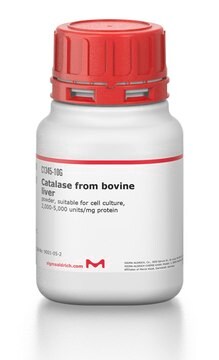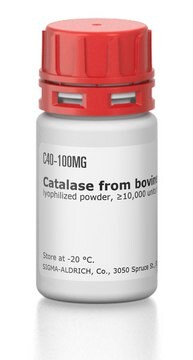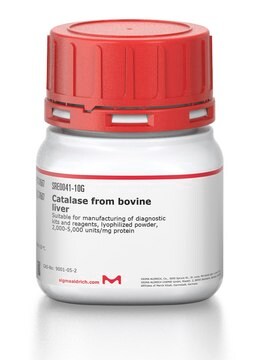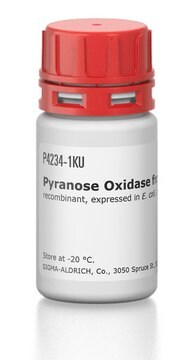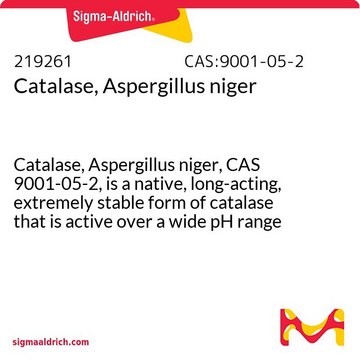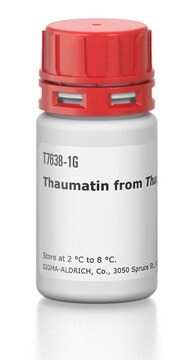E3289
Catalase from bovine liver
≥20000 units/mg protein, lyophilized powder
Sinonimo/i:
H2O2:H2O2 oxidoreductase
About This Item
Prodotti consigliati
Stato
lyophilized powder
Attività specifica
≥20000 units/mg protein
PM
tetramer ~250 kDa
Composizione
protein, ≥60% E405
Punto isoelettrico
5.4
Condizioni di spedizione
wet ice
Temperatura di conservazione
−20°C
Stringa SMILE
O(CC)C(=O)c1ccc(cc1)O
InChI
1S/C9H10O3/c1-2-12-9(11)7-3-5-8(10)6-4-7/h3-6,10H,2H2,1H3
NUVBSKCKDOMJSU-UHFFFAOYSA-N
Cerchi prodotti simili? Visita Guida al confronto tra prodotti
Descrizione generale
Catalase is encoded by the gene mapped to human chromosome 11p13. Mammalian catalase is an antioxidant enzyme and is a member of hydroperoxidase family). The active enzyme is homotetrameric in nature.
Catalase from bovine liver is a tetramer consisting of 4 equal subunits each with a 60 kDa molecular weight. Each of these subunits contains iron bound to a protoheme IX group. The enzyme will also strongly bind to NADP, where NADP and the heme group are within 13.7 angstroms.
Applicazioni
Catalase from bovine liver may be used:
- to prepare H2O2-O2 based biocathode for applications in glucose biofuel cells
- to study the kinetic properties and storage stability of catalase immobilized on to florisil
- in glutathione-mediated superoxide generation in an aqueous solution
- as a component of gloxy, which is one of the most popular oxygen-scavenging systems.
- in single molecule fluorescence resonance energy transfer (FRET) measurements.
- in cytochrome-C oxidase (COX) histochemistry to study the role of mitochondrial uncoupling protein 2 (UCP2) in limiting oxidative stress during glaucoma.
- to pre-treat slide chambers for total internal reflection fluorescence (TIRF) microscopy.
- in quantifying hydrogen peroxide release.
- to help minimize the effects of reactive oxygen species (ROS) in cooperativity assay for studying doublecortin and microtubule interaction.
Azioni biochim/fisiol
Definizione di unità
Stato fisico
Avvertenze
Danger
Indicazioni di pericolo
Consigli di prudenza
Classi di pericolo
Resp. Sens. 1
Codice della classe di stoccaggio
11 - Combustible Solids
Classe di pericolosità dell'acqua (WGK)
WGK 1
Punto d’infiammabilità (°F)
Not applicable
Punto d’infiammabilità (°C)
Not applicable
Scegli una delle versioni più recenti:
Certificati d'analisi (COA)
Non trovi la versione di tuo interesse?
Se hai bisogno di una versione specifica, puoi cercare il certificato tramite il numero di lotto.
Possiedi già questo prodotto?
I documenti relativi ai prodotti acquistati recentemente sono disponibili nell’Archivio dei documenti.
I clienti hanno visto anche
Il team dei nostri ricercatori vanta grande esperienza in tutte le aree della ricerca quali Life Science, scienza dei materiali, sintesi chimica, cromatografia, discipline analitiche, ecc..
Contatta l'Assistenza Tecnica.
